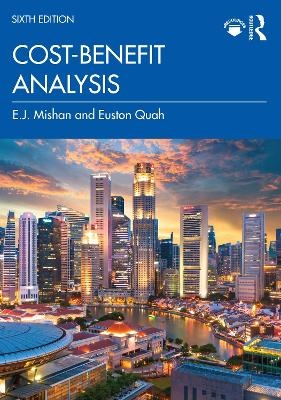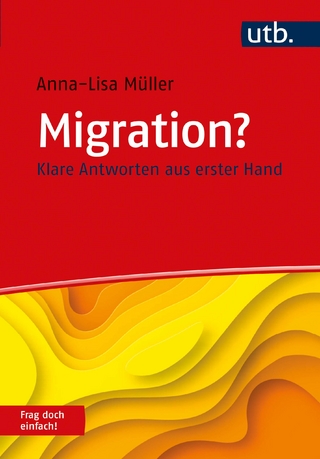
Cost-Benefit Analysis
Routledge (Verlag)
978-1-138-49275-2 (ISBN)
Cost-benefit analysis (CBA) is the systematic and analytical process of comparing benefits and costs in evaluating the desirability of a project or programme – often of a social nature. It attempts to answer such questions as whether a proposed project is worthwhile, the optimal scale of a proposed project and the relevant constraints. CBA is fundamental to government decision making and is established as a formal technique for making informed decisions on the use of society’s scarce resources.
This timely sixth edition of the classic Cost-Benefit Analysis text continues to build on the successful approach of previous editions, with lucid explanation of key ideas, simple but effective expository short chapters and an appendix on various useful statistical and mathematical concepts and derivatives. The book examines important developments in the discipline, with relevant examples and illustrations as well as new and expanded chapters which build upon standard materials on CBA. Highlights include:
updated historical background of CBA
extended non-market goods valuation methods
the impact of uncertainty
evaluation of programmes and services
behavioural economics
decision rules and heuristics
CBA and regulatory reforms
CBA in developed and developing countries
value of household production
other topics frequently encountered in CBA, such as costs of diseases and air pollution, and value of statistical life.
This book is a valuable source and guide to international funding agencies, governments, interested professional economists and senior undergraduate and graduate students.
The text is fully supported by a companion website, which includes discussion questions and PowerPoint slides for each chapter.
E.J. Mishan was Professor of Economics at the London School of Economics, UK, from 1956 to 1977. Euston Quah is Albert Winsemius Chair Professor of Economics at Nanyang Technological University, Singapore.
PART I - Scope and method (1) Brief historical background to cost-benefit analysis (2) What is cost-benefit analysis? (3) Framework to cost-benefit analysis PART II - Basic concepts of benefits and costs (4) Measurements of consumer surplus (5) Consumer surplus when several prices change (6) Consumer surplus when other things change (7) Introduction to the compensating variation (8) Measurements of rent (9) Is producer surplus a rent? PART III - Shadow prices and transfer payments (10) Introductory remarks (11) Opportunity cost of labour (12) Opportunity cost of unemployed labour (13) The additional benefits of using unemployed labour (14) The opportunity costs of imports (15) Transfer payments and double counting PART IV - External effects (16) Introduction to external effects (17) Adverse spillovers (18) Internalizing externalities (19) Evaluating spillovers (20) Compensating for environmental damage PART V - Investment criteria (21) Introduction to investment criteria (22) Crude investment criteria (23) The discounted present value criterion (24) The internal rate of return (25) The alleged superiority of the discounted present value criterion compared with the internal rate of return criterion and the net benefit ratio (26) Investment criteria in an ideal capital market (27) Calculation of rates of return and of time preference (28) Critique of the discounted present value criterion (I) (29) Critique of the discounted present value criterion (II) (30) The normalized compounded terminal value criterion (I) (31) The normalized compounded terminal value criterion (II) (32) The Pareto criterion and generational time (33) Cost-benefit analysis, weights and normative economics PART VI - Uncertainty (34) Risk and certainty equivalence (35) Decision rules and heuristics (I) (36) Decision rules and heuristics (II) (37) How practical are decision rules and heuristics? (38) Simple probability in decision making (39) Mixed strategies in decision making (40) Four additional strategems for coping with uncertainty PART VII - Topics frequently encountered in cost-benefit analysis (41) Valuation issues and methods (42) Benefit transfers (43) Pair-wise comparison (44) Cost-benefit analysis and behavioural economics (45) Cost-benefit analysis in developing countries (46) The value of time (47) Measuring the benefits of recreational areas (48) Travel cost method (49) Cost-benefit analysis and public health (50) The value of statistical life (51) Estimating the economic cost of air pollution on health (52) Economic cost of diseases (53) Cost-benefit analysis and the problem of locating environmentally noxious facilities (NIMBYs): an informal discussion PART VIII - Further notes and advanced materials (54) Cost-benefit analysis and the economist (Appendix 1) Cost-Effectiveness Analysis (Appendix 2) The alleged contradiction of the Kaldor–Hicks criterion (Appendix 3) The problem of second–best (Appendix 4) Origins of the Hicksian measures of consumer surplus (Appendix 5) Marginal curve measures of consumer surplus (Appendix 6) The concept and measure of rent (Appendix 7) Marginal curve measures of rent (Appendix 8) The limited applicability of property rights (Appendix 9) Deadweight loss or love’s labour lost (Appendix 10) The value of human life (Appendix 11) The rate of time preference (Appendix 12) Selecting a set of investment projects for given political objectives (Appendix 13) Why cost-benefit analysis is useful for regulatory reform (Appendix 14) Valuing household production
| Erscheinungsdatum | 11.08.2020 |
|---|---|
| Zusatzinfo | 51 Tables, black and white; 58 Line drawings, black and white; 58 Illustrations, black and white |
| Verlagsort | London |
| Sprache | englisch |
| Maße | 174 x 246 mm |
| Gewicht | 2040 g |
| Themenwelt | Sozialwissenschaften ► Politik / Verwaltung ► Staat / Verwaltung |
| Wirtschaft ► Betriebswirtschaft / Management ► Rechnungswesen / Bilanzen | |
| Wirtschaft ► Volkswirtschaftslehre ► Mikroökonomie | |
| ISBN-10 | 1-138-49275-2 / 1138492752 |
| ISBN-13 | 978-1-138-49275-2 / 9781138492752 |
| Zustand | Neuware |
| Informationen gemäß Produktsicherheitsverordnung (GPSR) | |
| Haben Sie eine Frage zum Produkt? |
aus dem Bereich


